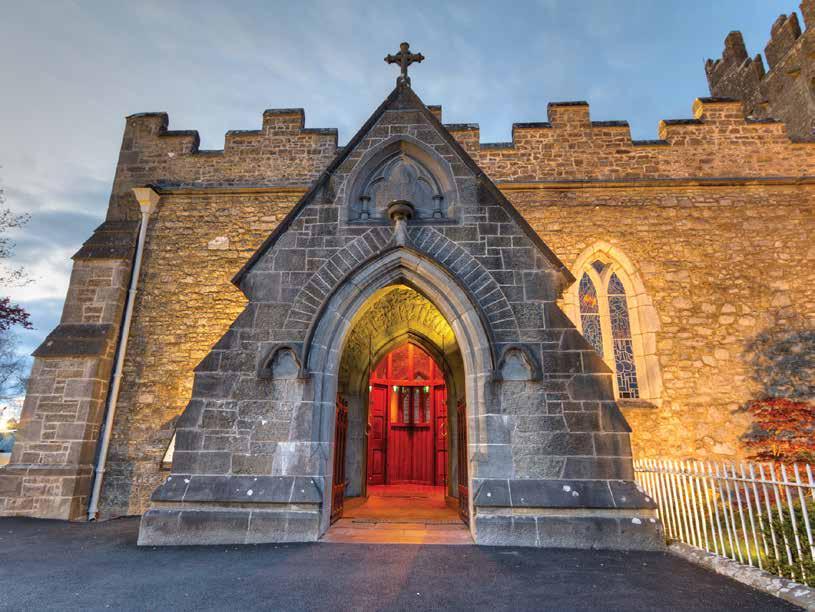
14 minute read
History & Heritage
St. John’s Cathedral Cathedral Place 061-414624 www.limerickcathedral.com
One of the most iconic sights on the Limerick skyline is the magnificent spire of St. John’s Cathedral.
Advertisement
The foundation stone was laid in 1856 and its crowning glory, the magnificent tower, was completed in 1882. The Catholic cathedral— which replaced a church founded in the 1753—was designed by English architect of note, Thomas Hardwick.
St. John’s Cathedral
The Cathedral of St. John the Baptist, to give it its full name, has many interesting features. The exterior, in Victorian Gothic style, was influenced by Salisbury Cathedral and was built by local builders, Wallace & Sons, out of Limerick limestone.
The altar table is of Limerick marble and there are numerous fine examples of stained glass windows, statues and eccelesiactical art within. Six bishops are interred here.
The tower, designed by local firm, Messrs. Hennessey, measures around 81 metres (including a cross atop it) and is one of the tallest church spires in Ireland. The bell was carried from Dublin via canal at the time.
Although it has undergone restoration over the years, the cathedral has been in continuous use since it opened in 1861. Mass times are available on the website.
The Treaty Stone Thomond Bridge
No visit would be complete without seeing Limerick’s most famous landmark, the Treaty Stone. According to lore, the Treaty of Limerick was signed on this very stone on 3 October 1691 within sight of two opposing armies on Thomond Bridge. The treaty ended the second Siege of Limerick and a bitter war between William III and his father-in-law, King James II.
The Jacobites sheltered in Limerick and were besieged by the opposition. Jacobite commander, Patrick Sarsfield, “ No visit would be complete without seeing
Limerick’s most famous landmark, the
Treaty Stone
Bishop’s Palace Church Street
also The People’s Museum of
Limerick, no. 2 Pery Square 061-313399 www.limerickcivictrust.ie www.peoplesmuseum.ie
Bishop’s Palace was painstakingly restored by Limerick Civic Trust and now stands as a testament to their great work in the city as the organisation’s headquarters.
When the trust acquired the building in 1986, it had been vacant for two decades and was condemned, but LCT would not let such a prominent part of the city’s history go to ruin. The corner site, just across from the castle on which the building rests, is a fixture on early maps. The building today is an early 18th century reproduction in the Palladian style - the only example of its kind in Limerick and one of the oldest buildings in ‘Englishtown.’
The massive building has a classical facade and doorway; it also has a unique balcony window on its gable end. The interior is lavishly decorated with period features like fireplaces and a stained glass window bearing the trust crest. It incorporates items The Best Of Ireland Series
The Treaty Stone
who sued for peace. The treaty agreed terms, including tolerance of the Catholic religion in Ireland.
The Treaty Stone is thought to be a stone step used to mount a horse and has had several resting places over the years. It currently resides directly across the river from the castle.

salvaged by the trust such as a mill wheel, a gothic entryway and an iron gate.
Under the Acts of Settlement after the Cromwellian Wars of 1649-51, it was granted to the Church of Ireland bishops. The bishops are believed to have occupied the building until 1784, after which it became privately owned.
The trust’s HQ is the starting point for many projects for its mission: “Improvement of our environment through positive action.”
Limerick Civic Trust runs walking tours and other events.

Limerick embracing a


There’s a real sense of momentum in Limerick – the gateway to the Wild Atlantic Way.
The historic city and county, just a short hop from Shannon Airport, has launched a new brand and international marketing campaign designed by global marketing giants M&C Saatchi to encourage everyone to see the city and county with fresh eyes.
“Limerick: Atlantic Edge, European Embrace” is the new brand aimed at internationalising the city and county. The new branding aims to ambitiously place Limerick at the most dynamic global crossroads, while at the same time capturing the sense of warmth and resilience so evident there. The brand is designed to target domestic and international visitors, students, business and investors and to enhance civic pride amongst Limerick’s locals.
So why now? There’s a palpable energy in Limerick about where the Treaty county is going. A new tourism strategy predicts that the number of visitors to Limerick will reach 1.1 million a year, generating more than €360 million in revenue and creating 1,500 new jobs by 2023. “ Limerick: Atlantic Edge, European
Embrace
The four-year plan has identified Limerick’s position as a gateway to the Wild Atlantic Way as central to developing the sector.
In 2020, Ireland became the largest English speaking nation in the EU. Limerick City and County sought to maximise this opportunity, creating a brand identity to unify everything Limerick does.
The new brand features the word ‘Limerick’ in bold typeface, with structural, colour and textural elements whose origins are distinctively from and of Limerick. The blues of the Atlantic and of course, Limerick’s finest natural asset – the River Shannon and the verdant, lush green landscape of Limerick county inspire a blended colour palette. 3D mapping of local landmark ‘The Treaty Stone’ evokes textures suggesting Limerick’s grit, character and deeper story. In developing the brand, the team drew on input from multiple stakeholders from across the community, as well as engagement from local producers such as Limerick School of Art & Design and Limerick Printmakers, amongst others.
In a short period of time, “Edge” and “Embrace” have become the frame through which Limerick’s storytelling takes place – Limerick’s brand identity now provides a distinctive design
embracing a BRIGHT future

thread to connect all activity and to locate Limerick in people’s minds.
The Limerick brand’s initial campaign, a major multi-market campaign, ‘Percentages’, is a cornerstone of the programme which quantifies Limerick’s combination of edginess and friendliness. The character and culture of Limerick is articulated through a roll-out of Limerick ‘heroes’, which sees inspirational people tell their stories on video as faces of the campaign, to amplify the sense of edge and embrace that typifies the city and county.
The future looks bright for tourism developments in Limerick.
The Great Southern Greenway Limerick, a 39km walking and cycling off road route running through Co. Limerick is soon to be completed. A multi-million euro International Rugby Experience backed by JP McManus and Paul O’Connell, among others, is set to open on O’Connell Street in 2021. Limerick’s Adare Manor, home to the county’s first Michelin Star is gearing up to host the Ryder Cup in 2026. “ The future looks bright for tourism
developments in Limerick
Limerick is a destination with new energy and intent, particularly exhibited by the local population, be they businesses or individuals.
For more details on Limerick, log on to Limerick.ie the official guide to Limerick or follow these hashtags on social #Limerick
#LimerickEdgeEmbrace #HowLimerick WALK THE THREE BRIDGES Starting at Arthur’s Quay Park. Follow a stunning route along the banks of the Shannon crossing Matthew Bridge, passing St Mary’s Cathedral and the historic King John’s Castle before crossing Thomond Bridge and passing the Treaty Stone on Clancy’s Strand.
Rock Solid Heritage
From ancient settlements to medieval splendour, abbeys to castles, the structural heritage of Limerick has endured through the ages and there are lots of sites to explore.
Ireland’s Prettiest Village, Adare
With its thatched cottages and grand manor house, Adare is a picturesque village with a rich history. The shell of Desmond Castle, which shadows the banks of the River Maigue outside the village, and the Franciscan, Trinitarian and Augustinian Abbeys suggest a long-term settlement. But the village itself really sprang up in the 18th century when the Earl of Dunraven built a huge house and estate. The 19th century rebuild of Adare Manor is now a spectacular hotel and golf resort. The Adare Heritage Centre can inform visitors about the history as well as point them towards a wealth of shops, fine bars and restaurants and local activities like golf and angling.

The Medieval Village of Askeaton
The medieval village of Askeaton was once a stronghold of the Munster Geraldines, the Anglo-Norman Earls of Desmond. Today, the impressive ruins of Askeaton Castle are an imposing sight in the town. It has a fascinating history. The building, which hosted Askeaton’s Hellfire Club, dates back to the 17th century. ‘Hellfire clubs’ were gentlemen’s clubs where men would gather to drink and make merry, but there are various spooky, occult associations with them too. The ruins of the well-preserved 14th century Franciscan Friary are also in the village. Tours are available from a local guide. The village has many modern conveniences too, including a wellequipped leisure complex.
Kilmallock History Trail 063-91300
Kilmallock, known as the ‘crossroads of Munster,’ was an important Norman town and was at the centre of Ireland’s political development from the 13th through to the 17th century. This history is evident through the rich architectural heritage of the town’s monuments. Along with the wellpreserved ruins of the Dominican

Franciscan Friary, Askeaton

Holy Trinity Abbey Church in Adare

Friary, there are the remains of medieval walls with a huge castle gate type entrance when entering the town from the Limerick City direction. There is also an interesting museum and history trail to enjoy.
Glenstal Abbey 061-621000 www.glenstal.com/abbey
Glenstal Abbey is a Benedictine monastery in Murroe in east Limerick and on its impressive 500 acre grounds, it has a secondary school and a farm. The current Abbott is Brendan Coffey OSB and the community itself has just under 40 monks. The abbey itself—dedicated to St Joseph and St Columba—is based in and adjacent to a Normanesque castle built by the Barrington family. The grounds are ideal for exploring and walking and include lakes, woodland and a walled, terraced garden containing a unique ‘Bible Garden.’ Visitors are welcome, especially those seeking spiritual respite.
Mungret Abbey
Just to the south of the road from Limerick to Askeaton on the R859 road, Mungret Abbey reportedly dates back to 551 AD when a monastery was founded here by Saint Nessan. It grew into a thriving community with six churches and 1,500 inhabitants, but declined after many Viking raids.

The site was reputedly given over to the Bishop of Limerick in the 11th century and one church later became a parish church. Three churches; one with a 15th century tower, and a graveyard survive now.
Kilmallock Dominican Friary

Desmond Hall 069-77408
Outside of the city, Limerick county abounds with many more sites of historical interest, and The Desmond Banqueting Hall in Newcastle West is among the most impressive of these. Built in the 15th century, the two-storey hall was used by the Earls of Desmond for banqueting and entertainment, and features magnificently restored medieval features such as an oak musicians’ gallery and a limestone hooded fireplace. A unique piece of heritage not to be missed, admission to Desmond Hall is free and by guided tour only.
These are just a small selection of the heritage sites around Limerick, which also includes Limerick Masonic Centre, Killagholehane Cemetery & Church, Carrigogunnell Castle, Glenquin Castle and more.
Image: Lough Gur
Neolithic Wonder

Lough Gur Heritage Centre Lough Gur, Co. Limerick 061-385186 www.loughgur.com
Lying just 21 km south east of Limerick city, the “magical and mysterious” Lough Gur is one of Ireland’s most important archaeological sites.
The story of the first settlers in the area stretches back 6,000 years— beginning in the Stone Age and continuing right up to modern times. You will be captivated by the beauty, charm and tranquility of this ancient place, its glassy lake and undulating hills.
Along with history, there is a wealth of folklore associated with Lough Gur. There are ancient dwellings, megalithic tombs, crannogs and castles to see here. The heritage centre is also located 5 km from the Great Grange Stone Circle, which is Ireland’s largest stone circle.
14 |
Guided and walking tours are available. Schools and groups are catered for, as is anyone who requires a personalised guided tour.
The newly refurbished visitor centre tells the story of pre-Celtic Ireland with the help of audio-visual features, interactive elements and displays of artifacts and replicas.
The Honey Fitz Theatre here hosts regular events and is a venue for festivals such as the annual storytelling festival.
and cycling on a variety of trails.
Opening times are Monday to Friday, 10am-5pm and 12 noon-6pm on Saturdays, Sundays and Bank Holidays. Please note that opening times are reduced during the winter.
Admission rates: Adults, €5, senior citizen/student, €4, children, €3 and a family ticket is €15. No fee to walk the grounds.

2Limerick boasts an array of museums, galleries and entertainment venues, and its strong cultural scene is enhanced by a large third-level population. Arts, Culture & Education

Limerick TheCulture Capital

If as writer, Thomas Merton, said that “art enables us to find ourselves and lose ourselves at the same time,” then Limerick is the ultimate lost and found collection.
The Treaty City and wider Shannonside has had a passionate connection with its own rich heritage, culture and the arts. Limerick remains a vibrant cultural hub in the Ireland today and has a great deal to offer, whatever your interest.
It is teeming with heritage sites, museums, galleries and performance venues. Limerick has been immortalised in several famous texts by those “bred and buttered” here.
In Frank McCourt’s memoir, Angela’s Ashes, the lanes, life and local characters of 1930s and 1940s Limerick are vividly drawn.
In Mike Finn’s play, Pigtown, the protagonist, Tommy Clocks, illustrates a century of vibrant Limerick history from the ‘Limerick Soviet’ to ‘The Emergency.’ Most recently, in 2019, the Centenary year of the Soviet, ‘Bread not Profits,’ also by Mike Finn, was a spectacular and emotional production, which took over the historic Cleeves Condensed Milk factory.
In John Breen’s Alone It Stands, the momentous rugby victory of Munster over the All Blacks in 1978 is recounted in all its mud-soaked, bone-crunching glory.
From award-winning fiction writer, Kevin Barry to wildly successful children’s writer, Darren Shan to our adopted son Donal Ryan and Irish language writer, Críostóir Ó Floinn, Limerick residents have proven they have the ‘write’ stuff. Limerick Writers’ Centre holds regular events and workshops, as does the group for emerging writers, Stanzas, and Narrative 4, a collective seeking to “improve the world through the exchange of personal narratives.”
“It remains the most vibrant cultural hub in the mid-west today
Limerick has produced its fair share of stars of stage and screen too. Oscar nominated actor, Richard
© Alan Place
Harris, of Gladiator and Harry Potter fame, and most recently, Ruth Negga (Loving, Shirley, Agents of S.H.I.E.L.D.) both honed their craft in Limerick and brought it to international acclaim. They are in good company with broadcasters Terry Wogan, Geri Maye and Emma O’Driscoll and Jon Kenny and Pat Shortt of comedy duo, D’Unbelievables as well as Liam O’Brien who starred in the UK soap, Emmerdale. Film director, David Gleeson, hails from Limerick. Theatre—amateur and professional— and musical theatre has a massive presence here.
Local companies include Bottom Dog Theatre Company, Limerick Youth Theatre, Amalgamotion Theatre Company, Magic Roundabout Theatre Company, Wildebeest Theatre Company, Beyond the Bark and Honest Arts, the Cecilian Musical Society, Limerick Musical Society, Quarry Players, College Players and Torch Players.
These are in addition to many individual practitioners and groups working here currently, and a constant stream of touring productions in local venues.
Local band, The Cranberries, and the late, lamented superstar Dolores









